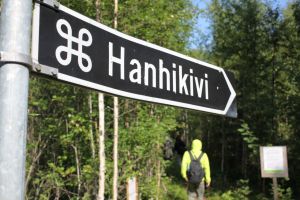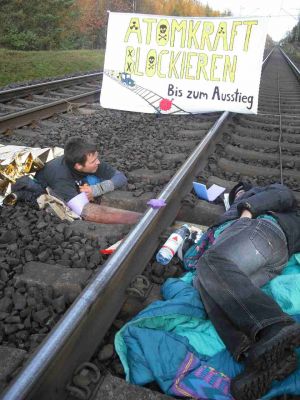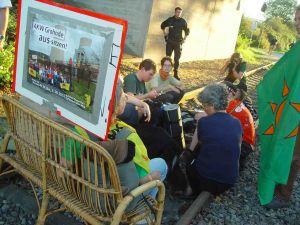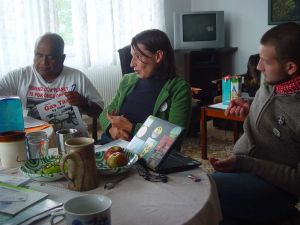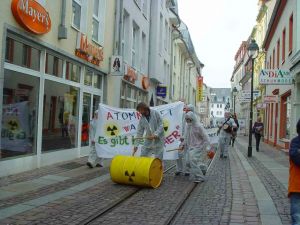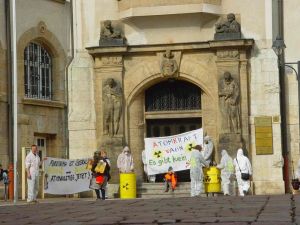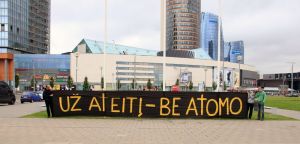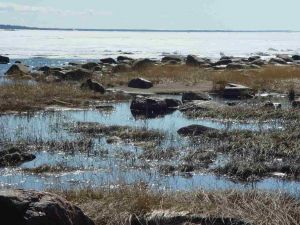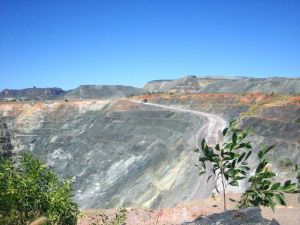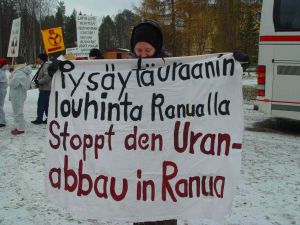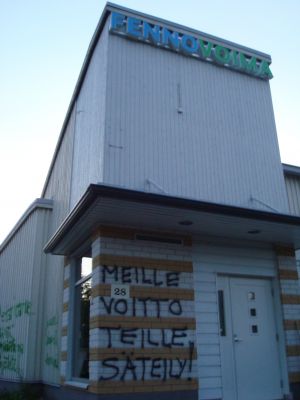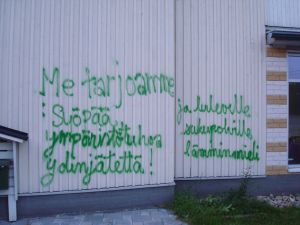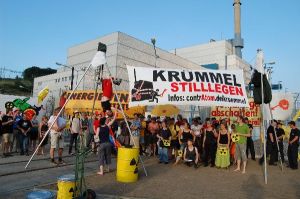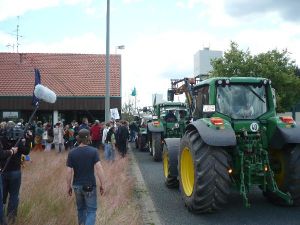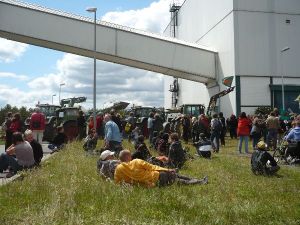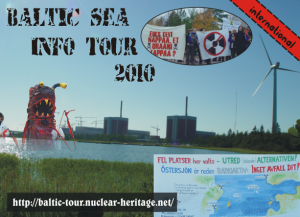Difference between revisions of "Nuclear Heritage Network"
(Fennovoima link) |
m ({{Translations}}) |
||
| Line 1: | Line 1: | ||
| + | {{Translations}} | ||
| + | |||
{| style="float:right;" | {| style="float:right;" | ||
|- | |- | ||
Revision as of 06:45, 17 October 2013
| Languages |
[[::Nuclear Heritage Network|English]] • [[::Nuclear Heritage Network/cz|Czech]] • [[::Nuclear Heritage Network/fi|Finnish]] • [[::Nuclear Heritage Network/fr|French]] • [[::Nuclear Heritage Network/de|German]] • [[::Nuclear Heritage Network/li|Lithuanian]] • [[::Nuclear Heritage Network/ru|Russian]] |
Please help to support more languages for this page! |
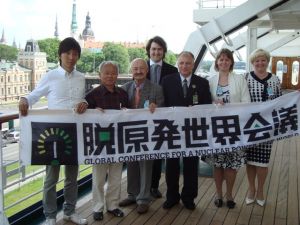 Peace boat stop in Riga (LV) May 22, 2013 |
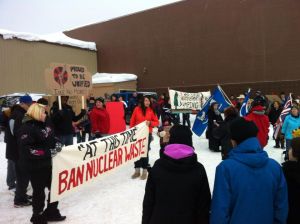 Idle No More - Indigenous protests in Saskatchewan (CA), January 2013 |
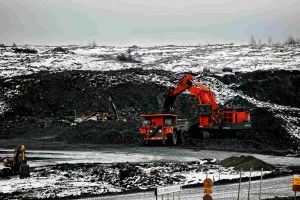 Disaster in Finland: uranium leaks in waste waters from the Talvivaara mine (FIN) to the environment |
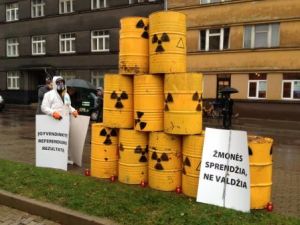 Riga (LV): Action against Visaginas NPP |
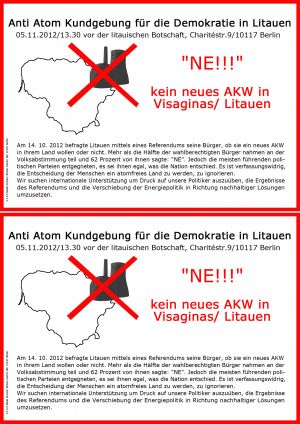 Action against Lithuanian Visaginas NPP in Berlin (D) on November 5th |
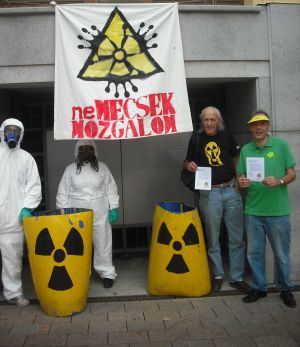 anti-Uranium mine action in Pécs (H) |
 Uranium Action Day took place on September 29, 2012 globally |
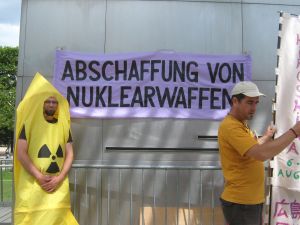 Fasten action against nuclear weapons in Paris (F) in August 2012 |
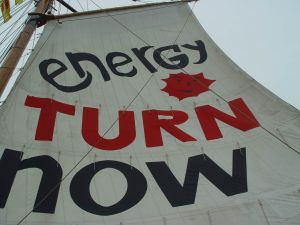 Anti-nuclear sailing trip headed from Stockholm (SE) to Greifswald (D) |
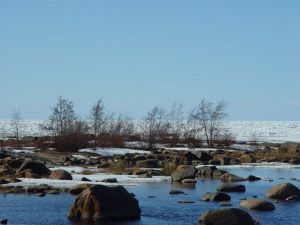 E.on subsidiary announced site selection for Pyhäjoki (FIN) |
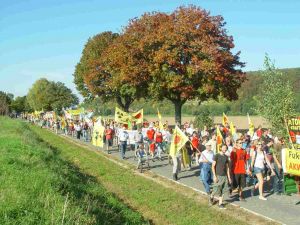 Rally and blockade of the Grohnde NPP (D) |
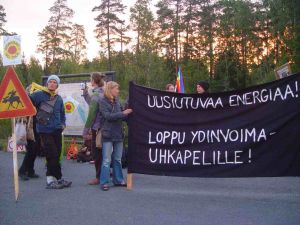 Access roads to the Olkiluoto NPP (FIN) successfully blockaded several times |
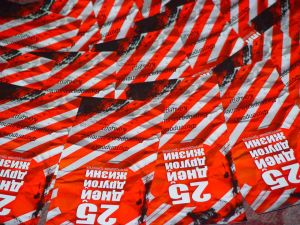 Launching the anti-nuclear art project "25" in Murmansk (RUS) |
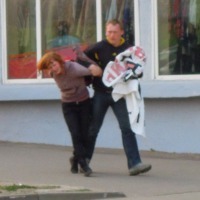 Special police forces arrested 12 activists after an international anti-nuclear action in Minsk (BY) on April 25 |
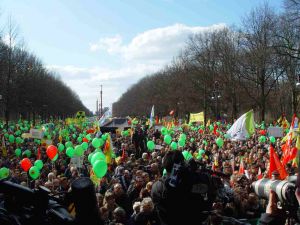 Fukushima demonstration: 250,000 protested in four German cities, 120,000 of them in Berlin |
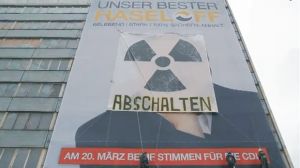 Action in Magdeburg (D): "Shut down" added to huge election banner of ruling pro-nuclear party (video) |
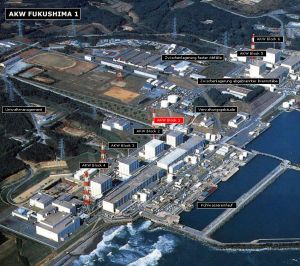 Overview of the nuclear facilities at the site of the NPP Fukushima I - provided by Spiegel Online |
 60,000 protested against nuclear power on 12/3/11 in a human chain between Stuttgart and NPP Neckarwestheim (D) |
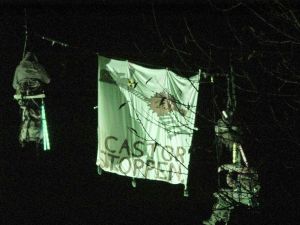 Climbing activists blockade the Castor transport at Morschen (close to Kassel, Hesse, D) |
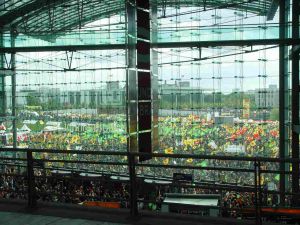 100,000 protested in Berlin against atomic power |
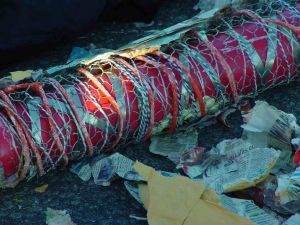 Olkiluoto successfully blockaded in Finland on August 28, 2010 |
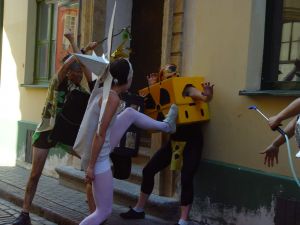 Renewables beating nuclear power in Riga! |
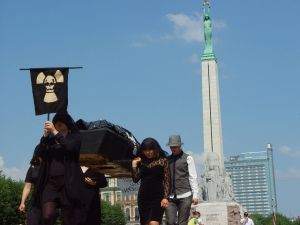 Anti-nuclear funeral action group in front of the statue of liberty in Riga |
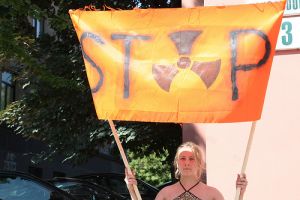 Actions against NPP developments in front of the Polish, Swedish and Finnish embassies in Vilnius |
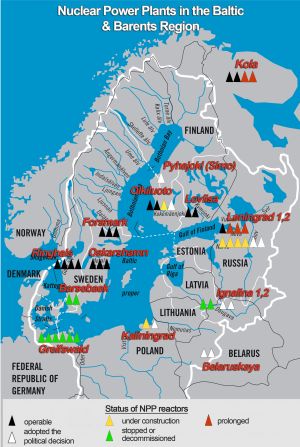 Nuclear power plants around the Baltic Sea |
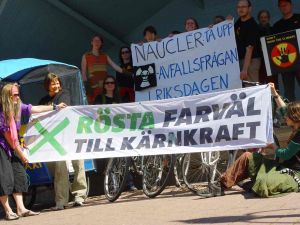 Action in Mariehamn |
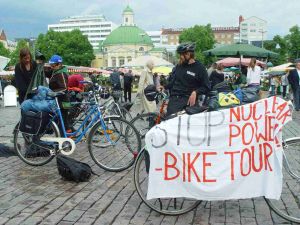 Anti-nuclear Biketour has started in Turku |
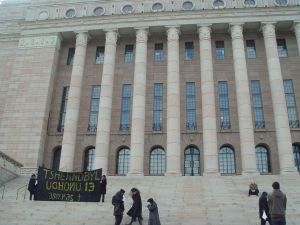 Chernobyl Day action of Women Against Nuclear Power in Helsinki, Parliament |
File:Baltic Tour Flyer Page 1.png Baltic Sea Info Tour - getting started! |
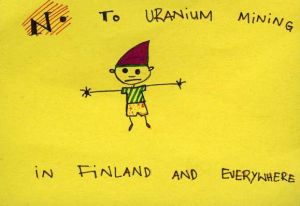 New postcards against uranium mining in Finland in several languages... |
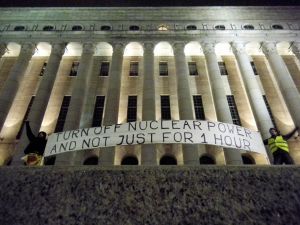 Helsinki (FIN): Action in context of an international network meeting |
 Protests against uranium mining in Finland |
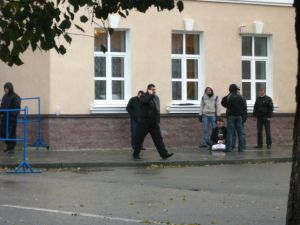 Russian anti-nuclear campaigner Andrey Ozharovskiy being arrested in Belarus while the hearings for the Environment Impact Assessment of the planned new NPP took place |
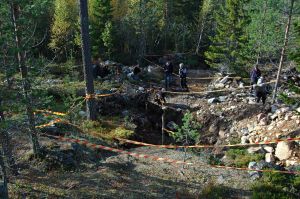 Activists examine the area of Areva's drilling activities |
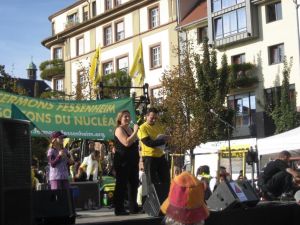 Shut down Fessenheim rally: Kerstin Rudek (BI Lüchow-Dannenberg) and Jean-Yvon Landrac (Sortir du nucléaire) |
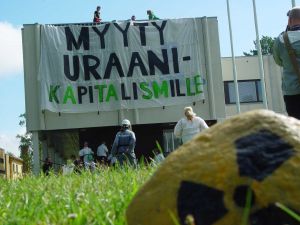 Nuclear Climate Camp: City Hall of Simo - "Sold to the Uranium Capitalism" |
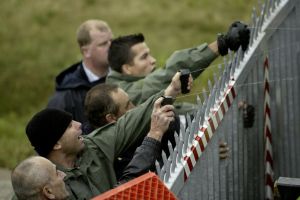 Police violance: Pepper spray against protesters from the Gorleben Treck in Morsleben (Photo: Andreas Conradt / PubliXviewinG) |
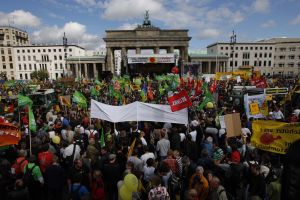 About 50,000 people demonstrated in Berlin against nuclear power (Photo: Andreas Conradt / PubliXviewinG) |
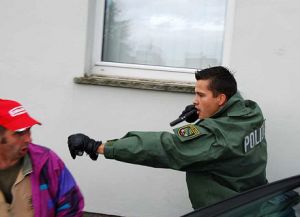 Policeman attacks a farmer in Morsleben with firearm |
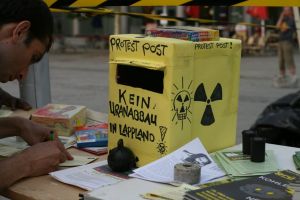 Ranua Rescue Action Day: post box for creative protest |
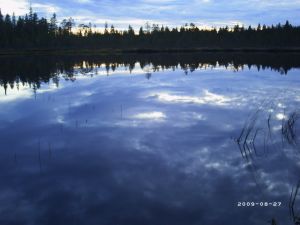 Near the Finnish Community of Ranua a camp has been set up to monitor Areva's mining activities |
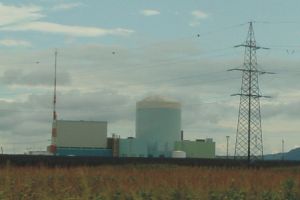 Slovene NPP Krško - visited during the International Network Meeting in Ljubljana |
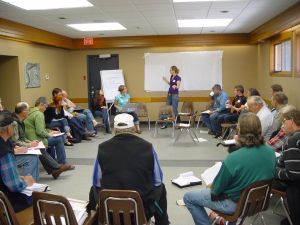 Canada: Tar Sands, new NPP plans & more concerned people at the Land Stewards Gathering in Edmonton |
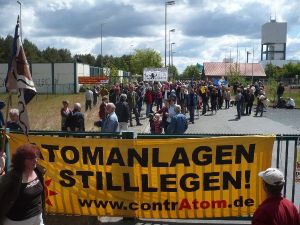 Germany: Some hundreds of activist occupied the illegal Final Disposal Site Gorleben |
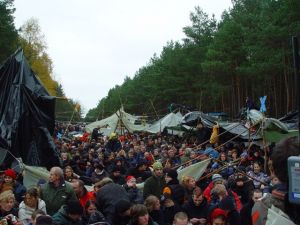 Castor: Mass blockade of thousands of people with tents, tarpaulins and tractors |
FUKUSHIMA DISASTER | UPCOMING EVENTS | RADIATION BULLETIN | NEWS | COMMUNICATION | ACTIVITIES | LINKS | PROMOTION
We want to connect anti-nuclear activists worldwide, provide information regarding nuclear issues and anti-nuclear activities in many countries and develop projects and campaigns. This website offers you background information, images, press releases, material and much more. Take some time to explore the Nuclear Heritage Network!
This website is based on the MediaWiki software (similar to Wikipedia) - this means you can edit pages, add your anti-nuclear contents or publish flyers. Help to extend the contents of our webpage, make translations or corrections and add new topics.
The Nuclear Heritage Network is more than this website. Twice a year we organize international network meetings, there are several mailing lists for communication and several international cooperation projects. We are also developing informational material on local topics in different languages for international use.
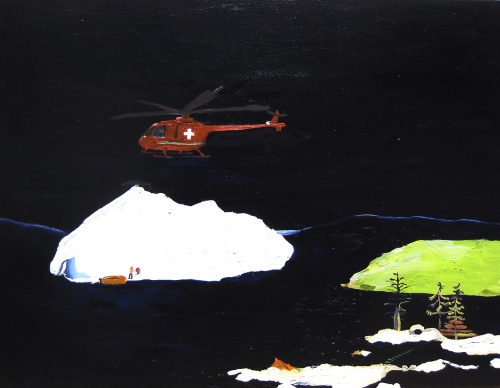
Talvivaara: Environmental Disaster in Finland
Since November 4, 2012[1] a cocktail of poisonous chemicals leaked from the Talvivaara mine in Eastern Finland to the surrounding rivers and lakes. An investigation of the Finnish Environment Institute found high levels of aluminium, cadmium, nickel, uranium and zinc in the released waste waters. In a big demonstration led by people from Eastern Finland on November 14, 2012 about 1,000 people demanded the mine's closure. A petition with some 18,000 signatures[2] was handed over to the Minister of Environment.[3] The number of signatures is still increasing - as of November 18 about 20,000 people had signed the petition[4]. At the same time a small rally took place in Oulu.
Only during the first day of the disaster, over 220,000 cubic metres of waste water have leaked from a gypsum waste pond at the Talvivaara mine in Kainuu. Some of the water has spilled to an area outside the mine.[5] The leakage continued for at least ten days. The operator of the mine tried for weeks to close the leak[6]. On November 8 they announced to have blocked a leak at its gypsum pond. Only half a day later a new leakage was reported.[6] The same happened again with the "all-clear" message of November 14th, when it was announced again the leakage was eventually blocked - one week later the safety dam was reported to be leaking again[7]. It is estimated that over 10,000 kilos of nickel and unknown amounts of uranium escaped the mine[6]. A new spill started in the night of April 8, 2013 releasing some 350,000 cubic meters of waste waters only within the first day[8].
Upcoming events
- Castor Resistance in Germany - probably 2024 in France, Germany and United Kingdom
Radiation Bulletin
|
Aug. 19th – 25th 2013 Germany spoke out this last week about EU attempts to mess with their plans to continue with a nuclear phaseout. There wasn’t a lot of news around the world other than the n-waste dump on Lake Huron on the US border with Canada that continues to heat up. Again, as mentioned there’s now been a howling by conservative papers across the country about how Obama broke the law and can’t be allowed to get away with it on his order to stop Yucca Mountain. Senator Reid continues to call Yucca dead. Speaking of leaks, a fairly serious leak happened at Hanford. There was literally no coverage of an NRC hearing on n-waste and spent fuel issues however. In a fairly serious turn of events, the Nation published a new story supporting nuclear power, relying on the recent pro-nuclear push out of the NY Times to rationalize the story, even quoting Pandora’s Promise! They at least put a link to their recent debate with Mark Hertzgaard however. Joe Mangano released a new report on the health impacts around the Palisades reactor. And of course there was one a media frenzy this weekend about an African found with enriched uranium in his shoes at JFK that will be making the terrorist rounds. Note that I pulled all the Yucca stories out of the top stories section and put them in the Fuel Cycle tab if you want to dig through them. Its kind of clear that there needs to be a bit of a response to this huge pro-Yucca spin. [edit WEEKLY STORIES] | [more stories] | [STORIES' ARCHIVE]
The Radiation Bulletin is published by the Abalone Alliance Clearinghouse |
News - Neuigkeiten
Finland: Rosatom- Fennovoima deal to continue Pyhäjoki NPP project
In the beginning of July the Finnish "Fennovoima" company announced they are going to sign a contract with Russian "Rosatom" to construct a 1200 MW nuclear plant at Pyhäjoki.
This announcement is not welcomed here. Legal experts say there are problems with this deal: permission given by the parliament was based on 2 alternatives: AREVA (EPR) and Toshiba (ABWR), both 1600 MW units. No environmental assessment was done for the Rosatom alternative. A new permission is needed, otherwise the democratic process written in the nuclear energy law has no real value. The Rosatom deal means a delay to the project, at least one more year.
Almost-disaster with burning nuclear ship in Hamburg/Germany
Mai 1st, 2013 the combined RoRo/container vessel Atlantic Cartier was on fire at the harbour of Hamburg (Germany). The fire was extinguished by 5 fire-fighting boats and 296 firefighters after about 16 hours. Only 500 meters from the burning ship the opening church service of Church Days was held with 35,000 people in the heart of the 1,800,000 citizens town. Nobody have been warned or evacuated.
Two weeks later an answer from the federal state parliament showed it was loaded with about 8.9 t fissile uraniumhexafluoride and 11.6 t fissile uraniumoxide or fuel rods beside 180 t Ethanol, about 3.8 t cartridges for weapons 2.6 t solid propellant and much more dangerous goods. The fire burned 70 new cars in the body of the ship, so some endangered containers right on the top were cleared in hurry during fire-fighting operations. The UF6 came probably from USA with destination Uranium Enrichment Facility Almelo (Netherlands)[9]. The uraniumoxide was supposed to be delivered to France.
Peace Boat brings message from Fukushima to Riga: Nuclear Free Now!
On Wednesday May 22, 2013, the Japanese based Peace Boat visited the port of Riga, Latvia with close to 800 participants onboard, including people from Fukushima. Peace Boat hereby invites interested media, NGOs and members of the public to join us on this occasion for a press conference and discussion onboard the ship.
Environmental scandal at uranium exploration project in Bahi, Tanzania
For more than five years, a number of foreign companies has intensively explored potential uranium reservoirs in different parts of Tanzania. Recently, a mining licence has been issued for the Mkuju River Project, partly owned by ARMZ, Russia. For this project the borders of the UNESCO protected world heritage Selous Park has been accepted by the WHC. Also concerned are the wetlands in a hollow without outlet in Bahi in Central Tanzania, some 50 km west of the capital Dodoma. For the inhabitants of this otherwise semiarid region it is of big important for growing rice, fishing, grazing, manual salt production in small amount, etc.
From the very beginning, the exploration was forced by high governmental levels, particularly by the Ministry of Mining. The inhabitants or their rights were not respected. Even the simplest security measures as filling up the exploration dikes were not brought into action. As far as we know, there was also no monitoring of possible releases of radioactivity for instance by the TAEC Tanzania Atomic Energy Commission or of other dangerous materials like heavy metals.
The residents of the village expressed their objection of the uranium mining plans in several gatherings and with the collection of signatures, because they fear the destruction of their natural resources.
In the end of 2012, several companies - Mantra Resources, International Gold Mining, Tanzoz, and the specialized US drilling company Layne - against the citizens' volition executed an intensive drilling programme on the territory of the villages Bahi Makulu and Illindi. In Bahi Makulu, particularly an area called Mashamba Mapya ("new field") was concerned. It had been prepared for growing rice only five years before. Since the rains starting in December 2012, an accumulated number of health problems is appearing with people having contact with the water from the concerned area.
Background information on Lithuania's nuclear policy
Lithuania is decommissioning the Soviet built Ignalina nuclear power plant and is planning a new one at the same site, despite that citizens voted against it in a nation-wide referendum held on October 14th, 2012. In the past Ignalina nuclear power plant (INPP) consisted of two RBMK type reactors (the same as in Chernobyl), which were built while Lithuania was member of the Soviet Union. INPP produced up to about 70-80 percent of the country's electricity. In 1992, a nuclear fuel cassette was stolen from the Ignalina nuclear power plant. In 1994, a terror act was proposed and the power plant was stopped for a few days. Lithuania had to close INPP as a condition to join EU, due to safety reasons. The first reactor was closed in 2004, the second in 2009. INPP now is the biggest energy consumer in the country. In 2010, radioactive liquids were released in the surrounding area of the plant; it was officially claimed not to be dangerous.
Despite these difficulties, Lithuanian politicians are planning a new atomic power station (Visaginas - VNPP) at the same site. In 2006, Lithuania, Latvia and Estonia decided to build the new nuclear power plant together. Later Poland joined the project, but recently was hesitant whether to want to join the project when they got to know the conditions with the constructor Hitachi-GE. In 2007, Lithuania's parliament adopted a law on building a new NPP. The law also stipulated the creation of a "national investor" to gain investments for the new nuclear power plant[10].Nuclear plant near Kaliningrad – bad story that must be ended immediately
For the first time in Russian history, the national nuclear corporation "Rosatom" is attempting to build nuclear reactors not for domestic supply but for the export of electricity to foreign countries. This is the case with the Baltic nuclear power plant in Kaliningrad region, located close to the border of the EU member Lithuania, which opposes this project.[11][12]
The energy demand in Kaliningrad is covered presently (as of spring 2013) for 100%. This is due to new natural gas power plant build just two years ago. And it should not come as surprise that Kaliningrad residents opposed to this nuclear plant. If built, the nuclear plant near Kaliningrad will put people under the risk of a new Fukushima and, additionally, will produce nuclear waste, dangerous for the next million of years. And money will go into the pockets of nuclear industry.
Since 1990, the nuclear industry attempted to lobby for the nuclear plant in Kaliningrad at least three times. But every time local authorities were opposed to the nuclear development. That position changed after the federal government in Moscow introduced a political reform. Moscow started to appoint new governors by the decision of president, instead of public elections. And the first governor which came from Moscow to manage Kaliningrad - Georgy Boos - quickly decided to build the nuclear power plant. Three years later he was dismissed as a result of largest political protests in the last 20 years in Kaliningrad.
Atomic Policy in Latvia
From 1940 to 1990 Latvia was a part of the Soviet Union thus its nuclear policy could not differ from the Soviet one. Main political and economical decisions were made by the Soviet government in Moscow and the government of Latvian Soviet Socialist Republic (SSR) had to implement them. Their power to object was limited.
In the 1950s Soviet government decided to build 20 research reactors in different regions of the USSR and abroad[13], following an initiative by Igor Kurchatov. Kurchatov was a Soviet nuclear physicist who is widely known as the director of the Soviet atomic bomb project.
However, the idea to build a research reactor in Latvia was a local initiative. It was a proposal from physicists from the Institute of Physics of the Academy of Sciences. The government of Latvian SSR forwarded it to the Council of Ministers of the USSR in spring 1958. The acceptance was received a few weeks later. The construction of „Salaspils Research Reactor“ (SRR) started in January 1959. SRR was put into operation in 1961 and carried out neutron activation analysis, nuclear reaction research, researches in solid state radiation physics, radiochemistry and radiobiology. It is the only research reactor Latvia has ever had.[14] SRR is located 2 km from the centre of Salaspils city and 25 km from Riga, the capital. It was shut down in 1998. The spent fuel was sent to Mayak Production Association in Russia in May 2008 within a bilateral governmental agreement.
Background information: Portugal: Uranium Mining
The struggle against nuclear energy has a long tradition in the environmental movement in Portugal. In 1974, shortly after the April 25th revolution that overthrow the fascist regime, the Movimento Ecológico Português (MEP - Portuguese Ecological Movement) was formed. The main big issue of this movement was the opposition to the building of the nuclear power plant in Ferrel, in Peniche. The anti-nuclear struggle evolved into a convergence of movements and citizens with ecological motivations under the CALCAN - Comissão de Apoio à Luta Contra a Ameaça Nuclear (Support Commission to the Struggle against the Nuclear Threat). A big anti-nuclear festival was organized and in 1977 a large march in Ferrel, initiated with the Church bells, marked the high point of the anti-nuclear struggle. The debate on whether to build a nuclear plant in Portugal continued until the 1980s. During this decade, the government definitely decided that Portugal should remain free from nuclear power.
Court decision: injunction against part of Talvivaara operation
The Vaasa Administrative Court has on April 2, 2013 given an interim decision on the emergency diversions that the Talvivaara mine invoked under Article 62 of the Environmental Protection Act. The mine claimed that emergency diversions are necessary to get the mine under control. The Kainuu ELY Center ruled that the diversions were legal. The Administrative Court has now overruled that decision and issued a temporary partial injunction, effective immediately. A final ruling will be made later.
The injunction limits the amount of water that can be diverted southwards to 7% of the water flow of the Kalliojoki river. This is the maximum amount allowed by the normal environmental permit. As such, it implies that as of now, no water in excess of the normal 1.3 million cubic meters can be discharged to the south of the mine.
Czech Ministry agrees on two new reactor blocks in Temelín
The Czech Environmental Ministry has given its OK to the planned building of two new nuclear blocks at the already existing location of Temelín NPP. Thousands of comments by Czech and foreign NGOs and citizens were put aside, basic questions of a formally incorrect EIA-process have not been answered, like: which reactor types will be used (AP1000 from Westinghouse, EPR from Areva or MIR.1200 from Rosatom), what to do with the nuclear waste and who will be paying for the dismanteling and secondary investments like new roads and the necessary grid improvements.
Besides that it is quite uncommon, that a leading person from the side of the investor (mainly state owned company ČEZ), Mr. Ivo Hlaváč, is changing his job to become vice ministry exactly for the period, when the investment project of his former company is being scrutinized by the Environment Ministry, his new employer. In the meanwhile he has returned back to his former company ČEZ. Czech NGOs like Calla and Jihočeské matky (Southern Bohemian mothers) now try to use legal means in order to bring this badly prepared project to an end.Indigenous protests against uranium mining, nuclear waste dumping and industrial abuse in Saskatchewan, Canada
The Jan 5th Idle No More rally in Buffalo Narrows was a powerful introduction of INM into northern Saskatchewan. It was attended by over 200 people of all ages, mostly Metis & First Nations representing the communities of (but not limited to) La Loche, Buffalo River First Nation, Dillon, Birch Ridge First Nation, Turnor Lake, Michel Village, Buffalo Narrows, Ile-a-la-Crosse, Canoe Lake First Nation, Beauval, English River First Nation, Patuanak, Pinehouse, Green Lake and Red Pheasant First Nation. There was a great showing from our youth.
The powerhouses of Idle No More in northern Saskatchewan are the young Metis and First Nation mothers Angella McKay of Buffalo Narrows, originally from Ile-a-la-Crosse, and April Rogers of Treaty 6, with her children being of Treaty 10, Birch Ridge First Nations. These young women are a beautiful force to be reckoned with, because they are coming from a place of love for their children. Also organizing and drawing from decades of experience were Marius and Candyce Paul of English River First Nation.
Demonstrators in Russia insisted on righting pervasive nuclear defects
Activists across Russia used the 26th anniversary of the disaster at Chernobyl to spotlight ongoing problems in the country’s ailing nuclear industry - many of which demonstrators say could lead to a Chernobyl two as government and industry officials persistently ignore the lessons of Fukushima.
In Moscow, activists gathered outside the headquarters of Rosatom, Russia’s state nuclear corporation, demanding that dangerous high-power reactor experiments at Murmansk’s Kola Nuclear Power Plant (NPP) cease, and that Chernobyl-style RBMK 1000 reactors, 11 of which still function in Russia, be taken off the grid.
Nuclear renaissance. What nuclear renaissance?
The Financial Times (FT) reported in April that the parliamentary Energy Select Committee is to invite executives from big energy companies to a meeting, "amid concerns that Britain's 'nuclear renaissance' is under threat."
No wonder: the UK government is committed to plans for new nuclear power stations at eight sites, each with one or two reactors. However German power companies E-ON and RWE, the intended builders at two of these sites - at Wylfa in Anglesey and Oldbury in Gloucestershire - had announced that they were selling their Horizon joint venture to build nuclear reactors in Britain, in part because of financial difficulties caused by Germany's retreat from atomic power after the Fukushima disaster. It has been suggested that Russian energy company Russcom (Chernobyl!), two Japanese energy companies (Fukushima!), and the Chinese State Nuclear Power Corporation might be interested, but Tim Yeo, Conservative chair of the energy select committee is reported by the Financial Times as saying that it was "ominous" that no buyer had come forward to buy Horizon.
Sizewell Chernobyl anniversary camp and demo
Buoyed by the success of running a full 50-seater coach from London to the Fukushima-anniversary demo against nuclear power at the Hinkley Point nuclear-power station in Somerset in March, London Region CND decided to run a similar coach to a similar demonstration at Sizewell, marking the anniversary of Chernobyl, in Suffolk on April 21st. This was the 4th annual demo held there to mark this anniversary.
This time, 40 people joined the coach in London, which was not bad considering the threatening weather. (The previous April only 21 had joined a similar coach from London.) This number was made to seem all the more respectable when we found that only about 100 people were there for the demonstration, as against the over 1000 that turned up at Hinkley. The demonstration consisted of long speeches from the eminent or representative interspersed with music, a little singing, and a heavy rain shower, as against the burning sunshine of the previous year, and ended with a symbolic blockade of the entrance to the power station. This year it was a standing blockade - the ground was too cold and wet to invite sitting!
The end of Fennovoima NPP project?
As predicted earlier this year, the Fennovoima project might end due to economic reasons.
Since this, several small shareholders have left the project, but the last nail in the coffin was an announcement from E.On to leave it as well. There are now about 40% shares for sale, but no buyer in sight. More shareholders are leaving, so all signs show this is the end of the project to build a 7th reactor in Finland.New Russian nuclear power: "Risk for Europe"
Oleg Bodrov and his lawyer, Andrey Talevlin, have appealed to the European Court of Human Rights after being denied access to a Russian court about the unlawful extension of operation permit for a Chernobyl-type nuclear reactor. Oleg Bodrov was recently interviewed by the French publication Journal D´Alsace about the reason for this appeal, during a visit in Strasbourg, seat of the European Court.
One of the Chernobyl-type reactors at the Leningrad Nuclear Power Plant, 40 km west of St Petersburg in Russia, was unlawfully given permission by the Russian regulator to continue operation beyond the lifetime-design time limit. The permission was given without a proper environmental impact assessment – EIA – or real public participation in the decision making process. This is contrary to Russian law. Bodrov was denied the right to try the case in a Russian court. As a private citizen he did not have the right to access to the court system. The Russian court also said the decision was made by the proper authority, and so all necessary safety concerns and environmental concerns were taken care of. The only possibility of having the decision about the life-time extension tried in a court was then an appeal to the European Court.
Belarusian anti-nuclear campaigners rejected from entering the EU
On 26 September the Belarusian antinuclear campaigners Mikalai Ulasevich and Tatsiana Novikava were not allowed to enter Lithuania on the reason of status of non-grata persons who might endanger the public order or the national security of Lithuania or others EU member states. They actually wanted to join the conference "Lithuania – Belarus: Nuclear Energy Neighborhood" held in the Lithuanian Parliament. They were officially invited to share their views on the problems of NPP construction and public participation in decision-making on nuclear energy in Belarus and Lithuania. - Sign the solidarity petition!
Marking Nuclear Waste Disposal Facilities
An issue that has long been on the radioactive waste management agenda is the means of marking a waste repository site, such that future generations will be able to comprehend its purpose and risks. Research into long lasting information carriers is being done, but how do 'future people' know there is a message inside, or even, where do we put it so 'future people' will find it before people start digging? And then the more principal questions, will such a warning not attract people to start digging? Or do we have to forget repositories ever existed? But how? Of course we have to stop producing nuclear waste immediately. But even then, the historical waste has to be stored. Responsibility to future generations implies that we necessarily have to do all to prevent future harm. This makes warnings to the future all the more necessary. But how?
In this article we discuss the three approaches over the past few decades (para 1, 2, and 3), a new emerging vision (para 4) and the question of permanent retrievability (para 5).
Anti-nuclear campaigners arrested in Minsk
A Coordinator of the campaign Tatyana Novikova and Russian nuclear physicist Andrej Ozharovsky, activists of Belarusian anti-nuclear campaign, were arrested this morning (18/07/2012). Now the activists are in Leninsky Police department of Minsk. Details of arrest are not known.
As website сharter97.org found out later, coordinator of the Monitoring Group of the Centre of Legal Transformation Michael Matskevich and chairman of the NGO "Eco House" Irina Sukhiy were also detained by unknown persons on the exit of the office of "Green Network”.
Irina Sukhiy was going to the Russian embassy, in order to pass the original of the petition against the construction of the Nuclear Power Plant in Belarus. Michael Matskevich was heading to Leninsky Police department, where, presumably, are located detained activists Tatyana Novikova and Andrei Ozharovsky.International Anti-nuclear Camp & Network Gathering in Middle Saxony/Germany
July 30 - August 3, 2012
You are invited to five days of workshops and presentations, skill-sharing and networking, excursions and public events in Döbeln, Middle Saxony. It will be a chance to meet activists and interested people from several regions across Europe to share experiences and ideas with each other and network for mutual projects and actions.
Everyone is welcome to offer workshops or presentations on topics they are working with. Please feel invited to talk about your current struggles, upcoming campaigns and actions. The gathering also aims to share our skills together in the fields of action, campaigning, investigating etc. It would be wonderful if you have issues you want to bring up.
We plan to visit an abandoned uranium mine at the Czech border not too far from the camp. There we will meet critics and learn about the challenges connected to uranium mining.
Stop Kola Nuclear Power Plant!
Nature and Youth (Young Friends of the Earth Norway) and one of our sister organizations in Russia, Priroda i Molodezh, have since February this year had an ongoing petition for the closure of an old and dangerous nuclear power plant in the North-West of Russia. Three out of the four reactors at Kola NPP are operating beyond the 30-year recomended lifetime, which makes it even more risky not to shut it down.
If you also want to support our campaign and learn more about Kola NPP, visit to our website (www.stopkolanpp.com) and sign the petition. Please make sure to share the link on facebook and/or twitter as well to make even more people aware of Kola NPP.
More information:
Lithuania's agreement with Hitachi criticized
Visaginas nuclear power plant (NPP) project would not be profitable. This is one of the reasons, why Lithuanian Green Party urges the Parliament not to approve the Concession Agreement with Japanese company Hitachi. The reasons were set out in Lithuanian Green Party's statement, prepared in cooperation with Lithuanian Energy Consultants Association and Green Policy Institute.Special report: Management of spent fuel and radioactive waste
Since the beginning of nuclear power the producing countries claim that "there will be a solution for nuclear waste soon", that "it is not a technical but a social and political problem".
This global overview of the state of affairs in 34 countries clearly shows that none of them have a final disposal facility, be it in deep geological formations or (near) surface. A very large majority of those countries are not even close. Some postpone the need for final disposal by long term interim storage of up to 100 years; and other countries use (the future option of) reprocessing as an alibi for postponing a decision.
Nuclear power is not a good business anymore
Recent news show nuclear power is not a good business anymore. After Fukushima accident, more projects have been cancelled around the world, but Finland seems to go on with new nuclear plants.
The Fennovoima project may have problems in financing, experts say. The biggest shareholder, E.On (34%) has already stepped aside from all nuclear projects and says it will concentrate on renewables. Small investors might have problems if the construction starts. Plant prices have risen about 100% from the beginning of the project. Making profit with new nuclear means electicity prices must rise.A nature catastrophy is being prepared in Eastern Lapland
The Norwegian public company Yara International is planning a phosphorus and niobium ore mining project in Sokli. There the phosphorus ores contain tenfold amounts of radioactive materials like uranium, thorium, radium and polonium compared to normal Sokli levels, the niobium ores even 200-fold amounts.
Covered by soil these radioactive materials are quite harmless, but during mining operations they are freed into the nature. Many uranium compounds are water soluble and spread easily with dust and drainage water into nature, where local inhabitants collect natural products like berries and mushrooms, reindeer is herded and ecotourists and fishermen wander in nature reserves.
Pack ice and bad engineering
The Fennovoima company was founded by E.On (Germany) and stainless steel producer Outokumpu (Finland) to become the third nuclear energy company in Finland. Outokumpu is a very power-hungry company, using about 300 megawatts of electricity 24/7. E.On has problems with it’s own nuclear reactors reaching end of life in Germany. Other members of this company are small industries and utility companies in Finland. The company business idea is called “Mankala-principle”, which allows the company to avoid all taxes when selling power to its shareholders. This kind of operation was twice questioned in Finland during the 1960’s, and is currently under examination of the EU commission as a violation to the directives.
Being a new player in the field, Fennovoima started its first reactor project with no engineering staff. There are no experienced reactor design engineers in Europe, as the last reactor by E.On started production in the 1980’s. Finland’s current reactors are 1970’s design, from USSR and Sweden. Because of Chernobyl accident, no new NPP projects were started in Europe until the troublesome Olkiluoto and Flamanville projets, both seriously behind their schedules and over budget.
Talvivaara: Uranium Extraction Permission for Europe's Largest Nickel Mine?
Talvivaara is Europe's largest opencast nickel mine. Started in 2008, the mine operates 24 hours a day, everyday, in the Kainuu region of Finland, 550 km NNE from Helsinki. Mining, crushing, chemical bio-heap-leaching, and extraction facilities cover and area of 60 sq km, slightly larger than Manhattan Island, NY. Over 30 million tons was mined in 2010 and operations are expected to continue for 45 years, not including cleanup / restoration of the area. Talvivaara also extracts zinc, copper, cobalt, and uranium.
Russian based Norilsk Nickel has a 10 year contract with Talvivaara for nickel and cobalt which is smelted at their plant in Harjavalta. It is documented that heavy metals pollution in the land around Norilsk Nickel's original factory are at such high levels that it would be economically feasible to mine the soil of the area[15].
Numerous problems at Talvivaara include chemical spills, widespread regional air and water contamination and chemical fires at the processing facility. The Economic crimes division of the Oulu Police are now conducting two investigations. Meanwhile, local people have been advised not to use well water for drinking, washing or sauna and complain of skin rashes and other symptoms they believe are due to Talvivaara[16]. The Kainuu Regional Environment Centre has discovered four badly contaminated lakes and three others 'less badly' contaminated[17].
Radiation levels at the Gorleben atomic waste repository too high
The legal annual radiation limit for the Gorleben interim repository for high level radioactive waste is 0.3 mSv/a[18]. The Lower Saxony authority NLWKN on the basis of their measurements of the first half year of 2011 calculated an annual dose of 0.32 mSv[18]. Thus, no additional Castor containers with high level atomic waste could be brought to the repository. The proposed 2011 Castor transport would have to be canceled.
But, as this result doesn't suit the nuclear industry, new measurements were commissioned. The PTB, a federal authority well-known for their pro-nuclear studies in the past, published their results: 0.212 mSv/a[18][19][20]. An additional expertise by the TÜV (another expert organization supporting the nuclear industry) supported the PTB interpretation of the measurements[21]. A Greenpeace expertise calculated an accumulated annual dose of 0.305 mSv in case the proposed eleven Castor containers would be brought to the Gorleben repository in November and blamed the Lower Saxony Ministry of Environment for miscalculations in their data due to a wrong mixture of different measurements[22].
Besides that, the detected neutron radiation in Gorleben, situated 1.9 km from the repository, has been doubled since the beginning of the storage of atomic waste in the facility[23].
Polish Atomic Energy Policy to be commented
The Polish government has sent its plans for a future nuclear power strategy to the German Ministry of Environment. As part of a so-called strategic environmental assessment citizens of certain neighbour countries will have the possibility to submit between October 5, 2011 and January 4, 2012 their objections to the Polish Ministry of Economy.
- information on the website of the German Ministry of Ecology German
- Polish Energy Plan documents
- objection campaign | sign-up list German
Explosion in nuclear waste treatment facility near Avignon
As reported on September 12, 2011, there has been an explosion at 9.45 AM GMT in an oven to burn low level atomic waste in the nuclear facility Marcoule 30 km north of Avignon (F). One worker died, four workers have been injured, one of them seriously. The authorities established a security cordon outside the facility as radioation releases are possible. So far, a speaker for the safety authorities said in an interview for Tagesschau (German broadcasting), no radiation has been released yet. On the site also some small decommissioned nuclear reactors a decommissioned fast breeder reactor is situated. The facility, that is owned by a daughter company of the atomic company EDF, is partially used by Areva for producing the highly dangerous MOX fuel, a mixture of uranium and plutonium. The same day the French authorities declared the accident to have been finished. While the official version says that no radiation had been released, and the operator insists claiming it to be an industrial, not a nuclear accident, it came to public that the killed workers body was irradiated and had to be burried in a specially shielded coffin[24].
Learn more:
- BBC English
- Störfall Atomkraft German
- Tagesschau | Stern | Welt | Süddeutsche | Focus | Spiegel German
Finnish Olkiluoto NPP blockaded by international activists
A blockade of about 100 activists from Finland, Sweden, Germany, Russia, France, United Kingdom|UK and Belarus several times stopped the traffic on the access roads to the disputed Olkiluoto nuclear power plant in Finland. Police had announced to prevent the blockade of roads that were supposed to take place for the second time. They forced protesters from the streets again and again towards a bus stop nearby. Nevertheless, the activists succeeded several times to blockade the main access road to the NPP for some minutes, while an additional access street had been closed for some two hours by a wooden tripod construction with an activist on the top.
Olkiluoto is a peninsula at the western coast of Finland and one of two atomic power plant sites of the country. Currently the trouble reactor Olkiluoto 3 is under construction there. It was supposed to come into operation already in 2009, but so far hasn't been finished yet. Instead, the costs climbed nearly to the double of the projected number, and hundreds of construction failure have been critized by the authorities so far. Partial interruptions of the construction were also caused by these faults. The french company Areva with participation of the atomic branch of the German Siemens company is the leading constructor of the prototype of the EPR, the so-called "European pressurized water reactor".
Summer last year the Finnish government and the Finnish parliament decided in contrary to the for Finnish conditions strong protests to support the construction of some two or three additional nuclear reactors. No one in Finland needs there energy. Instead, the nuclear lobby hopes for profitable export earnings. Strangely enough, basically all new NPP projects around the Baltic Sea calculate with exporting their atomic electricity, although there is already an excessive supply of energy. Germany for instance, the country that closed seven nuclear reactors in consequence of the Fukushima disaster and that is seen internationally as "the" nuclear phaseout state, is still exporting electricity to the European market. However, in Finland the construction of Olkiluoto 3 is mostly a strategic project of the French-German nuclear industry that urgently needs a model NPP to be able to sell the EPR internationally. Costs obviously don't lay a major role.Extension of Kola NPP: А dangerous and unnecessary experiment
At the public hearings on June 9, 2011 in Polarnye Zory ecologists stated of the low quality of the EIA document preparation, the risks and uselessness of the project itself and demanded to carry out stress-tests adopted by the EU methodology.
On June 9, 2011 in Polarnye Zory public hearings on the preliminary Environmental Impact Assessment materials (EIA) of operating unit No. 4 of Kola NPP at 107% of nominal power were held. The hearing was attended by over 500 people, mostly employees of the nuclear station. There were 25 speeches, mostly containing gratitude to “Rosenergoatom” for support of sports, health and pensioners. Also 13 questions were announced from environmental organizations, mostly critical to the disputed project.
First NukeNews issue released
The NukeNews are a new newsletter system of the Nuclear Heritage Network provided in several languages. The NukeNews will provide anti-nuclear activists with information about atomic policy in several countries, anti-nuclear campaigns and actions as well as other messages believed by activists of the Nuclear Heritage Network to be important for other concerned people. The idea was created already in October 2008 during the international NUCLEAR weekEND. But it took several years to produce the very first issue of the NukeNews due to many activists being overloaded already by the pile of anti-nuclear tasks. Now it is accomplished - you can receive the first issue of the NukeNews in English, Finnish, German and Russian - it is supposed to finish the French version as soon as possible, too. Subscribe the language version of your choice on our "mailing lists" page!
The so-called German nuclear phase-out is a fraud
While the German government and some conservative media celebrate the recent strategy decision of Germany's leaders to be a consequent reaction to the atomic disaster in Fukushima and call it an advance, it is the opposite. With the latest (May/June, 2011) decisions of the ruling parties of Germany a partly extension of the remaining lifetime of the nuclear reactors is supposed to be set by law. The atomic industry receives an other guarantee for the continuation of nine reactors. And legalizes new Fukushimas and Chernobyls for at least eleven more years.
Yet not all details of the new policy are public, but by now it seems to become a gift to the nuclear industry, who already feared to lose now all of their NPPs. There is no indication that the closure of the reactors will be irreversible. In contrast, one reactor is supposed to be kept on stand-by to be possibly reactivated again. In a couple of years the nuclear industry could start to negotiate again claiming it would not be possible to close their NPPs - as they did before, too. As the experience with the so-called German phase-out teached us the last ten years, only those reactors being closed down provide a chance not to be reactivated again - although Greens and Social Democrats in their federal government even found possibilities to reactivate them virtually by admitting the industry to add the theoretically remaining lifetime of an already closed reactor to other NPP's lifetimes. The new "plan" says the remaining nine reactors are supposed to be closed 2015, 2017, 2019, 2021 and 2022 - enough time for the nuclear lobby to try to phase-out the phase-out again, as they did already a couple of months before the Fukushima disaster occured.
It seems that the arithmetically remaining lifetime of the oldest nuclear reactors is supposed to be added to the legal lifetime of the newer ones (which are all very old, too). Even the legal lifetime capacities of those NPPs which are offline or closed due to accidents or court decisions will be added to the remaining reactors. As accidents and incidents are usual in the nuclear industry, the final year of closure of the last reactor could be even much later than 2022 due to the rule that the interruption time doesn't count on their legal lifetimes.
According to the available information about the results of the negotiations of the ruling parties, those seven nuclear reactors that have been offline as a consequence of the catastrophe in Fukushima as well as the Krümmel NPP that has been offline for many years due to a series of accidents will not be restarted again. This is probably the only good news, that the government doesn't dare to restart them - mass blockades of these reactors have been announced for the point of time when the moratorium would end.
The anti-nuclear movement in Germany, environemntal NGOs, oppositional parties on federal level as well as the big number of federal states' governments not ruled by the parties of the federal government, are currently putting much pressure on Angela Merkel and her cabinet to improve the nuclear phase-out ruling the governmental parties had decided on May 30, 2011. Some details were already changed due to the negotiations, like the gradually closure of nuclear power plants instead of leaving all of them in operation until 2022. And it also seems that the proposed and by the former red-green government in the old phase-out law legally fixed possibility of transfer of remaining reactor lifetime rights will be eliminated. These are successes not of the conservative government or the anti-nuclear pretending green party being responsible for having created the framework for the extension of the NPP lifetimes, but of the anti-nuclear movement.
NUCLEAR SAFETY OF THE BALTIC & BARENTS REGIONS
Over the past forty years, 32 nuclear power plants (NPP) have been constructed and operated in the Baltic and Barents regions. Taking into account their operating experience, all countries of the Baltic region have got divided into two groups: nuclear optimists and nuclear pessimists. Thus for safety reasons, the countries located in the west of the Baltic region either refused construction of the new nuclear power plants (Denmark) or started decommission process of the existing power units (Germany, Sweden, Lithuania). At the same time, the countries in the east of the region either extend the service life of their old NPPs (Russia) or build the new nuclear plants (Finland and Russia). The new NPP construction projects are being most actively promoted exactly along the border of division between the nuclear optimists and the nuclear pessimists.
Biketour headed from Turku to Mariehamn for the start of the Baltic Sea Info Tour
On Tuesday June 22 the Nuclear Baltic Sea Info Tour starts in Mariehamn in Finland. On Saturday June 19 an anti-nuclear bike tour started from Turku (Finland) biking through the archipelago heading to Mariehamn. The purpose was to slowly start the bigger Baltic Sea Info Tour that will travel around the sea for two month until middle of August. The bike activists also wanted to tell locals on their way about the harms of nuclear power which directly affect the area where they were biking. They also wanted to show that traveling can be fueled by our own power.
The biketour started on Saturday 19th of June from the Turku market square, a central place with a lot of commerce, where there was a short info happening. People were handing out flyers and there was a banner announcing the purpose of the bikers gathering there: Stop Nuclear Power! - bike tour. In general people showed interest and several people stopped to talk longer. The basic feeling was nice and exciting, even though there had been rain promised for the whole weekend. There were 12 people taking part between ages 3 to 53. The people taking part were coming from different parts of Finland and there was also a Belgian activist.
Accidents in Nuclear Power Plants - Increasing Number With Raising Age
A recently published statistical report of the German radiation protection authority BfS showed an increasing amount of accidents and incidents in German nuclear reactors: In certain Pressurized Water Reactors the number of those incidents is raising since 1994. This tendency is connected to the age of the reactors and shows the necessity to close down these risky facilities immediately. The upgrading measures aiming to improve the safety have even worsened the risk as the statistics show. At the same time when more incidents happen, the probability of a serious nuclear accident is increasing.
Another publication of the Austrian environmental NGO Global 2000 shows the operating and decommissioned European nuclear power plants and makes some of their accidents examplarily visible. A map of Europe shows these nuclear facilities. In Germany on average every three days an incidents occurs and in French NPPs there another incident takes place on average every two days.
sources:
148,000 Protested Against Nuclear Power in Germany
On Saturday 24 April, a few days before Chernobyl Day, some 120,000 demonstrators formed a 120 kilometer human chain between the Northern German NPPs Brunsbüttel and Krümmel - both reactors have been offline for years due to accidents. A convoy of tractors and other vehicles traveled from the Gorleben region for several days and joint the activists at the NPP Krümmel. Some additional 10,000 to 20,000 protesters encricled the NPP Biblis in the federal state of Hesse, which is the oldest German NPP in operation and which already accumulated about 800 accidents and incidents since its operation start. At the waste repository for spent fuel elements in Ahaus some 6,000 to 8,000 people protested against the planned waste transports to Ahaus and against the governments plans to extend the lifetimes of the German reactors.
Finnish Governments Proposal for Two New Reactors: Crazy and Irresponsible
On Wednesday the Finnish government announced that they will put a proposal to build two new nuclear reactors in Finland to the Finnish parliament: an additional plant at Olkiluoto in the Eurajoki region and a NPP for "Fennovoima", the German joint venture with several Finnish companies to establish a third nuclear site in Finland in addition to Olkiluoto and Loviisa. No-one but the nuclear industry needs more nuclear power plants in Finland. It's a shame that the Finnish authorities seem to be in bed with the nuclear companies.
The Finnish government's incomprehensible decision to support further new reactors has met with harsh criticism from anti-nuclear activists across Europe and beyond. The government is obviously willing to sacrifice people's health and the environment to the nuclear industry's profits. Anti-nuclear groups around the Baltic Sea plan an information tour in the summer, to educate about the impacts of nuclear facilities on the environment and people living in the region and to raise the awareness of the dangers associated with nuclear power.
No uranium mining in Alentejo - Portugal's radioactive legacy
Sheep and goats graze under the cork trees, the sun glitters silver on the leaves in the olive groves; gardens full of orange and mandarin trees; the streams gurgle sweetly as they flow; the aroma of ham, smoked sausage and the famous Nisa cheese is in the air: all around the little mediaeval city of Nisa, in Portugal, there is a wealth of tradition and good flavours. And that' s something that the people there, in the northern part of the Alentejo, don't want to give up for anything - least of all for uranium mining.
Portugal has been exploiting its uranium reserves as long as anywhere. The first license for mining this yellow, radioactive heavy-metal was issued a hundred years ago in 1909. After the Second World War Portuguese uranium oxide was used by both the Americans and the British for their nuclear industry and atomic bombs. By 1991, 62 mines, most of them in the central region orf Portugal, were already producing the mineral, but since then production has slowed, mainly because the price of uranium on world markets collapsed. Now, however, demand for this nuclear fuel has risen again, and since 1998, with higher prices, the prospect of mining has hung over the 3,600 residents of Nisa like a radioactive sword of Damocles as in 1959, about two kilometers from the edge of town, they discovered the biggest unexploited reserves of uranium anywhere in Portugal. Sixty percent of all uranium ore in the Alto Alentejo lies here, more than six million tonnes, of which about 650 tonnes of uranium oxide can be extracted.
More Wind Power in Germany
Munich (dpa) - The consolidation of German wind power has reached a new record according to information of the "Süddeutsche Zeitung". After two years of stagnation the number of new wind power stations that started operation rose again in 2009, the newspaper reported on Wednesday (January 27th, 2010). According to a study of the "Deutsches Windenergie-Institut (DEWI)" the major renewable power generation branch has been clearly growing faster than expected. Therefore during the last year, nearly 950 wind power stations have been connected to the grid with a total capacity of 1917 megawatt - an increase of 15 percent compared with the previous year. This corresponds to the capacity of two nuclear power plants. Worldwide only the USA has a larger number of wind power stations. According to the report Germany reached a total capacity of 25,800 megawatt. The latest surge was surprising. At the beginning of the year, the branch had expected a deficit because of the worst economic crisis since decades.
Source: Greenpeace Magazin (German)
Almost 50% of Albertans 'conflicted' about nuclear power, report says
More than a quarter of Albertans oppose allowing nuclear power plants to be built in the province, while almost half remain "conflicted" about the energy source, according to a new government report released Monday (Dec 14, 2009).
And people north of Edmonton - were several nuclear plants have been proposed - were more likely to oppose building the plants, by around 32 per cent, compared to the Calgary region, at 24 per cent, was the least opposed.
"Only those Albertans who hold consistently positive views of science and the nuclear industry - and are less concerned by the potential for negative consequences - actually want to see the government encourage nuclear proposals," said the report by Alberta Energy.
German Energy Giant RWE Withdraws from Bulgarian Nuclear Power Plant
In a letter to the Bulgarian Energy holding, the German company RWE announced on October 28th its withdrawal from the controversial Belene nuclear power plant (NPP) in northern Bulgaria. RWE cites doubts about the project´s profitability as the major reason for the company´s retreat.
"For the past 18 months, we´ve been pointing out to RWE that Belene is a high-risk project in terms of safety, economics, environment and corruption," says Heffa Schücking from the German environment NGO Urgewald. "It sure took the company a long time to face up to the facts," she comments.
RWE´s decision comes in the wake of a broad grass-roots campaign of German environment organizations against RWE´s investment plans in Belene. Some 30,000 German citizens sent letters and petitions to RWE´s CEO asking him to withdraw from the project. Several of the company´s major investors also spoke out against the plan to invest into a NPP in an area of high seismicity in a country with low nuclear standards and high corruption.
"This is the beginning of the end of Belene," says Petko Kovachev from the Bulgarian Green Policy Institute. "After 12 international banks decided to decline financing for the project in 2006 and 2007, RWE was Belene´s last hope," explains Kovachev. RWE was slated to provide 49% of the project´s equity and its decision to withdraw sends out a clear signal to investors and banks regarding the project´s questionable economics.
read the whole articleBelarus: Hearings on Environmental Impact Assessment falsified
Today, on the 9th of October, public hearings took place on the question of construction of a nuclear power plant. All the entrances to the cinema where the hearings were held got blocked by riot police and streets were filled with cops in civil. Documents and leaflets containing criticism of the EIA (Environmental Impact Assessment) were illegally confiscated because of their 'doubtful' contents. Employees of state institutions were brought to the hearings by buses. The forcedly assembled audience was registered in advance, in violation of regulations. Many registered participants were not let inside.
Advocating was allowed only to the state employees in favour of nuclear power plant construction, others were denied to speak. The denial was justified by the fact that they supposedly had registered late. Thus, the procedure of hearings didn't meet the standards and the results can't be recognized as independent.
The Russian expert in nuclear physics Andrey Ozharovskiy was arrested in the morning on a charge of disorderly conduct. At the moment he is facing the court. Only 4 people were let into the courtroom, 2 of which are the witnesses. Anonymous men in civil are blocking the entrance to the court-house and refuse to identify themselves.
Thus, the authorities showed their true face again - they are not going to let the dissidents speak openly on the important matters to those in power.
more info:
contact:
Belarus Anti-Nuclear Resistance
Anti-nuclear demonstration & conference in Colmar
On October, 3rd about 7,000 people took part in a demonstration in the French border town of Colmar (sited in Alsace, near the German-Swiss border) against the nuclear plant of Fessenheim. Speakers from France, Switzerland and Germany criticised the ongoing operation of the oldest nuclear reactor of France in Fessenheim and the expected decision to extend the reactor license for another 10 years. A minute's silence and wailing sirens illustrated a nuclear accident. Different music bands, street actions, a huge banner action and many yellow T-Shirts were just a few aspects of a peaceful and powerful demonstration against nuclear energy.
The prefect of Upper Rhine and the mayor of Colmar denied the demonstration to take place inside the town center of Colmar and moved it to a place in front of the city's train station. Authorities deployed about 3,000 police officers, dozens of anti-riot police vehicles and trucks with water cannons all over Colmar.
On Saturday evening and on Sunday different conferences and concerts took place on locations in and around Colmar. Different activists from around the world refered about uranium mining, actions of civil disobedience, the plans about new nuclear power plants in Switzerland and many other topics.
Polish Community Gives Up NPP Plans
The Polish border town Gryfino has given up its plans to build a nuclear power plant. "In view of the vehement protests in Germany it makes no sense to think about it anymore", mayor Henryk Pilat told the "Märkische Oderzeitung".
Especially the big demonstration of anti-nuclear activists in Berlin last weekend impressed him, Pilat continued. The local politician made clear that the town is most interested in the modernization of the old coal fired station "Dolna Odra". Some 2,200 employers are currently working for the power station.
(translated excerpt of an article in Märkische Oderzeitung from September 10th, 2009)
Camp in Ranua Set Up to Monitor Areva's Mining Activities
On August 26, a basecamp has been established for the Ranua Rescue Areva Mining Monitors. During the Lapland Nuclear Climate Camp in July, we learned from locals that Areva has already begun their uranium prospecting in Ranua, Lapland. We have come here to monitor Areva's activities and help support the resistance to uranium mining here, and everywhere.
We have found a beautiful location for the camp, near a lake, within an old forest, on the edge of Areva's massive prospecting claim area. We need thoughtful, respectful people, skills, supplies, support, laughter, and dedication!
You can check the site http://www.nuclearfreefinland.org, and the blog on http://www.ranuarescue.blogspot.com. Soon we will be sending photos and directions to get here, we will also set up a schedule for when people are most needed, what is needed, and what events will be happening.
When you want to come to the camp, contact in advance (camp (at) nuclearfreefinland.org) and tell us your arrival time in Ranua. From there you can phone the camp work phone number +358 40 365 2041.[26]
We can't trust Areva or the authorities. All their information is really contradictional. First both Areva and the environmental authorities said clearly: Areva doesn't and can't start the deep drilling before they get the claim. Areva has announced several times that they stop working because there is nothing they could legally do before the ministry's permission-claim.
BUT: there are at least two holes, and an expert said after seeing a foto that those look like drilling holes. No one knows how deep those are, as Kaipainen from Areva says they haven't drilled anything. The chief of the environment protection from "Lapplands enviroment center" didn't know anything about the holes (with white, sweating face), but wanted to have the fotos and after all said that AREVA IS ALLOWED TO DO DEEP DRILLING BY THE PERMISSION OF THE LAND OWNER, and there is nothing they can do unless they could proof that it would harm the environment seriously, the mere possibility is not enough. The boss of Areva says they are not doing anything, because they can't. But at the same time, they said on their website that they can start drilling by the land owners permission.
So we see that there is a need for observers. Ready to film whatever happens there, and call more people if they try to start drilling. Hopefully they won't, if they know it wouldn't stay hidden. But if they would be that stupid, we would be ready to act and the show would really start.
The idea is that the camp will stay there as long as needed, meaning also over the winter. Some people may visit one night, some longer. There are already tents with "fireplace", and the idea is to build the camp so that it will be possible, even nice, to be there during winter time as well (personally waiting for the northern lights...)
One point is, that Ranua council will, after all, vote on their opinion about the mining soon. Starting the camp just when they vote can be the best timing ever! Even if their "no" wouldn't save the situation, just make it a little bit better.
Study shows: Nuclear energy on downward trend worldwide
Source: Federal Environment Ministry of Germany English | German
The share of nuclear energy in worldwide energy consumption is marginal and has been declining for several years. This is revealed in a study by independent experts of the energy and nuclear sector which was published by the Federal Environment Ministry today. As Federal Environment Minister Sigmar Gabriel said: "The renaissance of nuclear energy, much trumpeted by its supporters, is not taking place. The only thing frequently revived is the announcement. The study shows: the number of old nuclear power plants which are decommissioned worldwide is greater than the number of new ones taking up operation. Available resources, engineering performance and funds are not even enough to stop the downward trend, let alone increase the number of reactors. All the facts are in favour of phasing out this technology while at the same time expanding the use of renewable energies and energy efficiency, as this is a promising option for the future."
The authors of the study, headed by Mycle Schneider, Paris, collected crucial quantitative and qualitative facts on nuclear power plants which are in operation, being built or planned today and assess the economic viability of old and new nuclear power plants.
At the time of going to press, 1 August 2009, there were only 435 reactors in operation worldwide, which is nine less than in 2002. Nuclear energy accounts for only about 5.5 % of worldwide commercial primary energy consumption and only around 2 % of worldwide final energy consumption - and consumption has been steadily declining for years.
The authors also found out that the number of nuclear power plants will decrease worldwide over the next decades. Between 2015 and 2025 the capacity of nuclear power plants is expected to sink compared to today's output.
Even with the support of countries seeking to use nuclear energy in future, this downward trend will not be reversed. It is unlikely that these states will be able to set up the necessary technological, political and economic framework conditions for a civil nuclear energy programme in the near future. Most of this states also lack electricity grids which would be capable of holding or distributing the output of a larger reactor.
Furthermore, the authors are concerned that there will be a considerable shortness of qualified experts in almost all countries. Even in France, which probably has the largest pool of nuclear energy experts, the lack is worrying. Currently, there are only 300 graduates of nuclear technology study programmes compared to a demand of 1,200 to 1,500.
In addition to staffing problems, industrial capacities are not sufficient either. For example, Japan Steel Works is the only company in the world able to manufacture the cast steel parts for the pressure vessels of the European Pressurized Water Reactor (EPR).
Current and planned building projects of the nuclear industry are becoming increasingly expensive. The EPR, for example, the flagship of the world's largest manufacturer of reactors, AREVA NP, which is currently in construction in Olkiluoto in Finland, has so far exceeded planned costs by at least 55 %.
New attention to Church Rock uranium spill comes 30 years later
Thirty years ago today, an earthen tailings dam near the United Nuclear Corp. Church Rock Uranium mine collapsed, spilling ninety million gallons of liquid radioactive waste and eleven hundred tons of solid mill wastes into the Rio Puerco.
The spill contaminated water, land and air at least 50 miles downstream on Navajo Nation land in New Mexico and Arizona.
It is believed that more radiation was released in the spill than in the Three Mile Island nuclear accident in Pennsylvania, making the Church Rock spill the largest release of radioactive waste ever in the U.S. — and second only to the Chernobyl meltdown globally. The privately-owned site of the Church Rock spill is a Superfund site — and it is still leaking radioactive waste throughout Indian lands to this day.
The New Mexico Independent, By Tracy Dingmann 7/16/09 9:35 AM
- Read the whole story: http://newmexicoindependent.com/31989/31989
Plans for new NPPs in Ontario/Canada seem to fail
In July 2009, the nuclear power provider Bruce Power informed that the company has decided to withdraw their applications for new Nuclear Power Plants in Ontario. The demands for electricity in the province don't provide a reason for these investments. Instead of constructing new NPPs Bruce Power now wants to concentrate on the refurbishment of their old reactors.[27] Just some time ago the administration of Ontario had suspended the plans to construct new reactors in Darlington because of the high costs[28]
Bruce Power emphasized that this decision doesn't mean that they would also cancel their NPP plans in Alberta and Saskatchewan. In these provinces, that don't have nuclear power plants yet, the company waits for the government's general decisions concerning nuclear power.[29]
NPP Krümmel Blockaded Using Concrete And Tripods / Krümmel Offline After Third Accident Within 14 Days
In 2007, the German NPP Krümmel had been shut down after several accidents happened. The main accident was a fire and an explosion in the nuclear power station damaging one of two main transformers. After two years, on June 19, 2008, the NPP was restarted. Only a few days later, on June 23, another "incident" occurred: an electronic device failed. On July 1, the second accident happened and caused a shutdown of the power station - another transformer problem was the reason. For the next two days it was operated with reduced power to be back at 100% on July 4.
To protest against the restart of the NPP, some 200 activists blockaded the gate of the power station on July 3 walling up the entrance and using tripods to block it. They were supported by farmers of the Gorleben region with their tractors.
Only one day later, on July 4, the NPP was again shut down due to new transformer problems. This series of accidents and "incidents" reveals the threats coming from the Krümmel NPP.
Communication - Kommunikation
You can contact us via e-mail europas-atomerbe ÄTT greenkids.de[25] or telephone ( +49 391-72 72 657). A wiki-homepage is being built at http://greenkids.de/europas-atomerbe.
On the longer run, this website and the communication in general are supposed to be at least bi-lingual (German/English) and if possible realised in even more languages.
Kontakt kann zu uns per Mail an europas-atomerbe ÄTT greenkids.de[30] oder telefonisch unter +49 391-72 72 657 aufgenommen werden. Eine Wiki-Internetseite für das Projekt entsteht unter http://greenkids.de/europas-atomerbe.
Langfristig soll diese Internetseite und die Kommunikation mindestens zweisprachig (deutsch/englisch), nach Möglichkeit auch darüber hinaus gestaltet werden.
Activities - Aktivitäten
"Europe's Nuclear Heritage" is a (research) project that is concerned with the usage of nuclear power and especially the debates on final repositories in Europe. Regarding these topics it works on networking between groups in different countries. Within this framework or associated to it the following activities took place:
"Europas Atomerbe" ist ein (Forschungs)-Projekt, das sich mit der Atomenergienutzung und speziell den Endlagerdebatten in Europa beschäftigt und hierzu auch eine Vernetzung verschiedener Gruppen in verschiedenen Ländern anstrebt. In diesem oder assoziertem Rahmen gab es bisher folgende Aktivitäten:
France - Frankreich
The current idea for the next possible project would be to visit the French exploration site in Bure combined with a meeting of local activists to also get a critical viewpoint.
Die derzeitige Idee für das nächste mögliche Projekt wäre eine Besichtigung des französischen 'Felslabors' in Bure (Wikipedia Artikel, Französischer Wikipedia Artikel) kombiniert mit einem Treffen mit dortigen Aktivisten um auch einen kritischen Standpunkt mitzubekommen.
Finland - Finnland
An excursion during February 2007 to visit the finnish nuclear power plant in Olkiluoto at whose site the final repository for highly radioactive waste is being planned.
Bei einer Exkursion im Februar 2007 ging es zur Besichtigung des finnischen Atomkraftwerks (AKW) Olkiluoto, an dessen Standort das dortige Endlager für hochradioaktiven Atommüll geplant ist. Beteiligt euch unter den untenstehenden Punkten an der Auswertung der Fahrt!
- Diskussion über einen Brief an TVO
- Eindrücke von der Fahrt
- gesammelte Fakten zu Olkiluoto, finnischer Atomenergienutzung und der Endlagerdebatte
- Vorbereitung der Finnland-Exkursion
Germany - Deutschland
Gorleben - Gorleben
In November 2006 a visit of the mine for final repository exploration at Gorleben was organised by the project. This included a visit of the underground facilities.
After this visit of the underground facilities and a lecture from the operating enterprise of the plant, we met Lilo Wollny, an old lady from the Gorleben resistance. She talked about the beginning of the protests and gave an overview of the security problems at the Gorleben nuclear waste disposal site.
Im November 2006 wurde im Rahmen des Projektes eine Besichtigung des Endlager-"Erkundungsbergwerks" im Gorlebener Salzstock organisiert. Diese enthielt auch eine Besichtigung unter Tage.
Nach der Führung durch den Gorlebener Salzstock und einem Vortrag der Betreiberfirma DBE trafen wir uns mit Lilo Wollny, einer alten Dame aus dem Gorlebener Widerstand. Sie erzählte uns von den Anfängen der Proteste und gab einen kleinen Einblick in die Sicherheitsbedenken gegen den Gorlebener Endlagerstandort.
Morsleben - Morsleben
An exhibition on the history of Germany's final repository for low and medium level radioactive waste at Morsleben, which is also available in english, is en route in different towns.
Eine Ausstellung zur Geschichte des deutschen Endlagers für niedrig- und mittelradioaktiven Atommüll Morsleben, die auch auf Englisch verfügbar ist, ist unterwegs in verschiedenen Städten.
In the past, a visit of the underground repository in Morsleben has also taken place.
There were several lobby meetings with different politicians to sensitize them for the problems of the Morsleben final repository and to exert pressure on the Federal Office for Radiation Protection to end their reluctance to give out information. These meetings are being continued throughout the year. Additionally, different actions and workshops took place on several occasions, including congresses and other events.
Auch in Morsleben wurde in der Vergangenheit eine Besichtigung im Endlager unter Tage organisiert.
Mit verschiedenen Politikern gab es 2006 Lobbygespräche, um für die Problematik um das Endlager Morsleben zu sensibilieren und um Druck auszuüben, damit die Informationsverweigerung des Bundesamtes für Strahlenschutzes ein Ende hat. Auch in diesem Jahr werden diese Gespräche fortgesetzt. Darüberhinaus fanden immer wieder Informationsveranstaltungen und Workshops in verschiedenen Orten und bei Kongressen und anderen Veranstaltungen statt.
Links
- Greenkids e.V. Germany
- Luonto-Liitto Finland
- art project "steine für morsLeben" Germany
- LovisaMovement Finland
- international anti nuclear conference in Helsinki 2007
- nirgendwo.info - German Campaign against the EPR reactor - Germany
- No Nukes Inforesource - information about nuclear facilities worldwide - English
- WISE - World Information Service on Energy - information and networking center for citizens and environmental organizations concerned about nuclear energy, radioactive waste, radiation, and related issues - English
- Preventing the Lake District from becoming a Nuclear Sacrifice Zone
- Radiation Free Lakeland - Blog
- 101 Uses for a Nuclear Power Station
... (please add your anti-nuclear links).
Background Information
- Information about Uranium projects in Europe
- Global Impacts of Uranium Mining
- IAEA Power Reactor Information System (pro-nuclear)
- Status und Trends der Atomenergie weltweit (PDF) German
Promotion of this Website - Werbung für diese Website
You can spread the internet addresses http://nuclear-heritage.de.vu and http://nuclear-heritage.net to popularize this website.
Du kannst die Internetadressen http://nuclear-heritage.de.vu und http://nuclear-heritage.net verwenden, um diese Internetseite bekannter zu machen.
- ↑ http://www.greenpeace.org/international/en/news/Blogs/makingwaves/chemical-spill-finland/blog/42935/ as at November 17, 2012
- ↑ figure corrected from 17,000 to 18,000 after a direct information from Helsinki on November 17, 2012
- ↑ http://yle.fi/uutiset/stop_talvivaara_protest_brings_carnival_mood_to_helsinki/6376956 as at November 17, 2012
- ↑ source: personal information by email from Helsinki on November 18, 2012
- ↑ http://yle.fi/uutiset/talvivaara_waste_water_leaks_into_environment/6363459 as at November 17, 2012
- ↑ 6.0 6.1 6.2 http://yle.fi/uutiset/talvivaara_waste_water_leak_plugged/6369461 as at November 17, 2012
- ↑ Stop Talvivaara media release as at November 23, 2012
- ↑ http://yle.fi/uutiset/new_waste_leak_at_talvivaara/6569276 as at April 8, 2013
- ↑ http://www.sofa-ms.de/home.html as at May 21,2013
- ↑ http://www.reuters.com/article/idUSL2870020520070628 as at April 28, 2013
- ↑ Press-release by the head of Lithuanian parliament, August 20, 2012 http://www3.lrs.lt/pls/inter/w5_show?p_r=4028&p_d=127841&p_k=2
- ↑ Lithuania has not received Russia's answers about safety of nuclear power plant in Kaliningrad, www.15min.lt, Sept 7, 2012 http://www.15min.lt/en/article/world/lithuania-has-not-received-russia-s-answers-about-safety-of-nuclear-power-plant-in-kaliningrad-529-247159
- ↑ Book "Salaspils zinātniskā kodolreaktora 50 gadi", Publishing House "Zinātne", 2010
- ↑ http://inventions.lza.lv/proto.php?id=131 as of April 24, 2013
- ↑ http://en.wikipedia.org/wiki/MMC_Norilsk_Nickel
- ↑ http://yle.fi/uutiset/teksti/news/2011/09/talvivaara_mine_dismisses_health_and_environmental_claims_2902005.html
- ↑ http://www.hs.fi/kotimaa/Kainuun+ELY-keskus+Talvivaara+pilannut+pahoin+nelj%C3%A4%C3%A4+j%C3%A4rve%C3%A4/a1305550727980
http://www.hs.fi/english/article/Chemicals+from+mine+contaminate+lake/1135269828385
http://www.iltasanomat.fi/kotimaa/Talvivaaran%20kaivoksessa%20tulipalo%20-%20vaara-alue%20evakuoitu/art-1288375809544.html - ↑ 18.0 18.1 18.2 https://www.gorleben-castor.de/index.php?cont=news&id=382&n=1 as at October 26, 2011
- ↑ https://www.gorleben-castor.de/index.php?cont=news&id=369&n=1 as at October 26, 2011
- ↑ http://www.contratom.de/castorticker2011.php?id=37487 as at October 26, 2011
- ↑ http://de.nachrichten.yahoo.com/strahlung-gorleben-laut-t%C3%BCv-auch-durch-weitere-castoren-124400783.html as at October 26, 2011
- ↑ http://www.contratom.de/castorticker2011.php?id=38034 as at October 26, 2011
- ↑ https://www.gorleben-castor.de/index.php?cont=news&id=372&n=1 as at October 26, 2011
- ↑ http://enenews.com/report-marcoule-victim-was-irradiated-buried-in-shielded-coffin-locals-disagree-with-govt-radiation-story-failure-to-disclose-what-was-burned-during-explosion as at September 23, 2011
- ↑ 25.0 25.1 For protection against automatical email address robots searching for addresses to send spam to them this email address has been made unreadable for them. To get a correct mail address you have to displace "AT" by the @-symbol.
- ↑ http://www.nuclearfreefinland.org/en/ranua-rescue-areva-mining-monitors-rramm, August 31th, 2009
- ↑ http://www.brucepower.com/pagecontent.aspx?navuid=1211&dtuid=84013 on August 3, 2009
- ↑ Bruce nixes 'more nukes' plan. The Toronto Sun, Fri Jul 24 2009 BY JONATHAN JENKINS, QUEEN'S PARK BUREAU
- ↑ http://www.brucepower.com/pagecontent.aspx?navuid=1211&dtuid=84013 on August 3, 2009
- ↑ Zum Schutz vor automatischen Mailadressen-Robots, die nach Adressen suchen und diese dann mit Spam-Mails überfluten, ist diese Mailadresse für diese Robots unleserlich formatiert. Um eine korrekte Mailadresse zu erhalten muss ÄTT durch das @-Symbol ersetzt werden.
